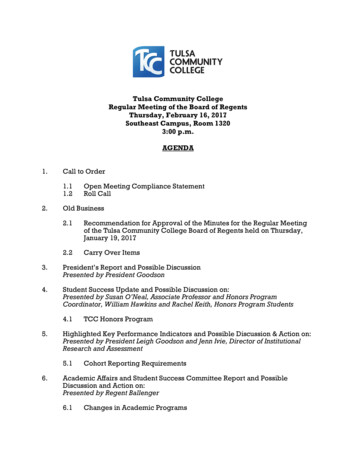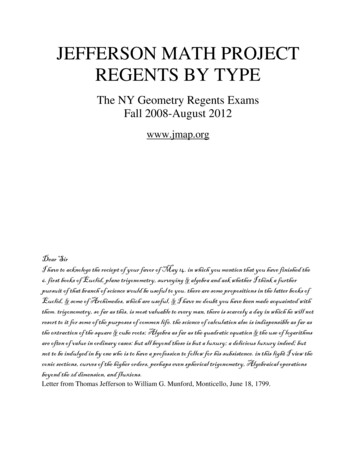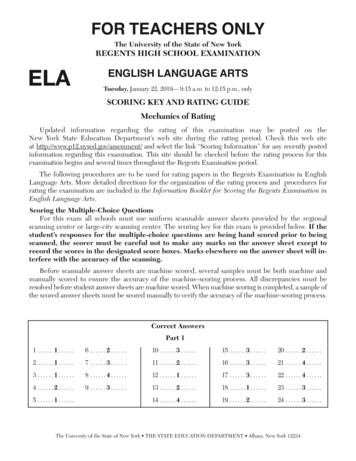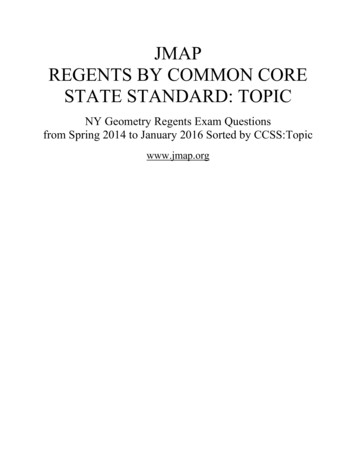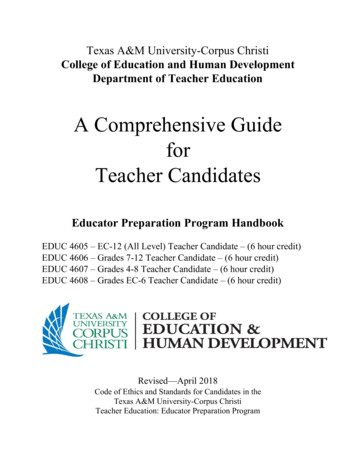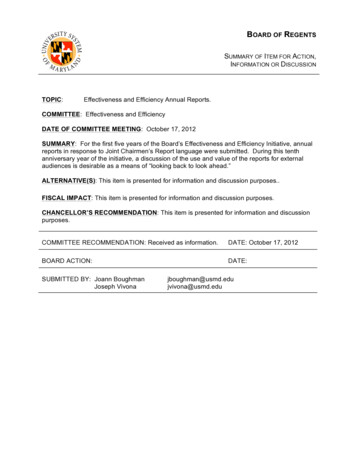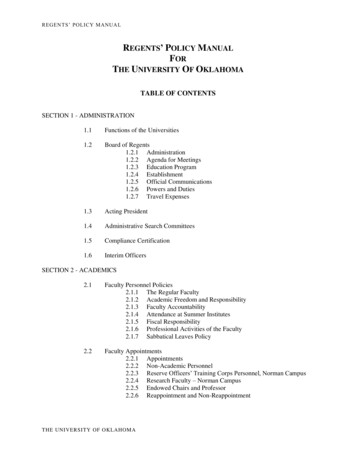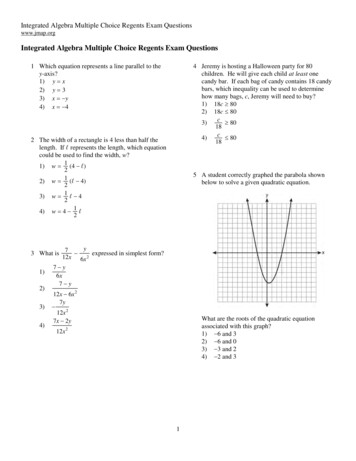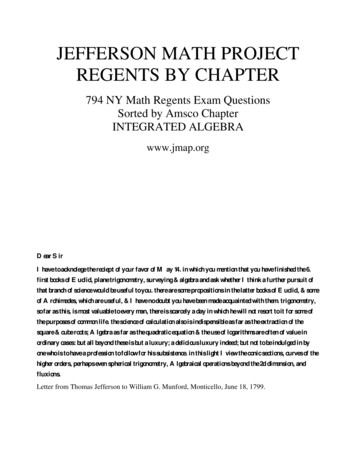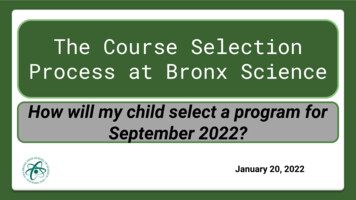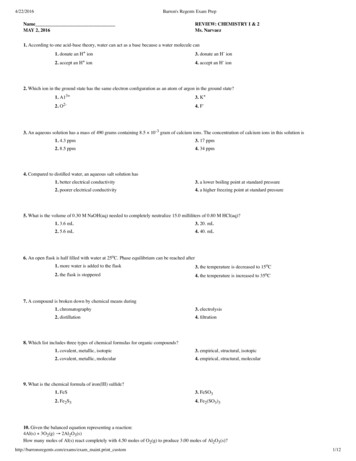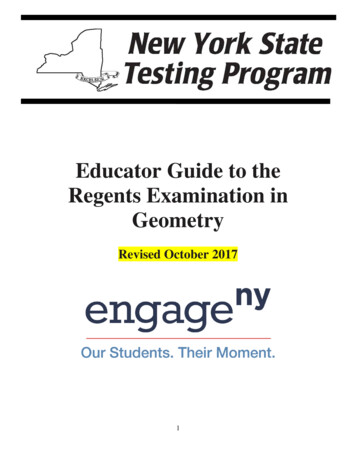
Transcription
Educator Guide to theRegents Examination inGeometryRevised October 20171
THE UNIVERSITY OF THE STATE OF NEW YORKRegents of The UniversityBETTY A. ROSA, Chancellor, B.A., M.S. in Ed., M.S. in Ed., M.Ed., Ed.D. .T. ANDREW BROWN, Vice Chancellor, B.A., J.D. .ROGER TILLES, B.A., J.D. .LESTER W. YOUNG, JR., B.S., M.S., Ed.D. . .CHRISTINE D. CEA, B.A., M.A., Ph.D. . .WADE S. NORWOOD, B.A. .KATHLEEN M. CASHIN, B.S., M.S., Ed.D. .JAMES E. COTTRELL, B.S., M.D. .JOSEPHINE VICTORIA FINN, B.A., J.D. .JUDITH CHIN, M.S. in Ed. .BEVERLY L. OUDERKIRK, B.S. in Ed., M.S. in Ed. .CATHERINE COLLINS, R.N., N.P., B.S., M.S. in Ed., Ed.D. .JUDITH JOHNSON, B.A., M.A., C.A.S. .NAN EILEEN MEAD, B.A. .ELIZABETH S. HAKANSON, A.S., M.S., C.A.S. .LUIS O. REYES, B.A., M.A., Ph.D. .SUSAN W. MITTLER, B.S., M.S. .BronxRochesterGreat NeckBeechhurstStaten IslandRochesterBrooklynNew YorkMonticelloLittle NeckMorristownBuffaloNew HempsteadManhattanSyracuseNew YorkIthacaCommissioner of Education and President of The UniversityMARYELLEN ELIAExecutive Deputy CommissionerELIZABETH R. BERLINSenior Deputy Commissioner for Education PolicyJHONE EBERTDeputy Commissioner of the Office of Instructional SupportANGELICA INFANTE-GREENAssistant Commissioner of the Office of State AssessmentSTEVEN E. KATZThe State Education Department does not discriminate on the basis of age, color, religion, creed, disability, maritalstatus, veteran status, national origin, race, gender, genetic predisposition or carrier status, or sexual orientation in itseducational programs, services and activities. Portions of this publication can be made available in a variety offormats, including braille, large print or audio tape, upon request. Inquiries concerning this policy ofnondiscrimination should be directed to the Department’s Office for Diversity and Access, Room 530, EducationBuilding, Albany, NY 12234.i
Table of ContentsCommon Core Regents Examinations in Mathematics.1Instructional Shifts and how they will be reflected in the MathematicsAssessments .1Regents Examination in Geometry.2Conceptual Categories .2Regents Examination in Geometry Blueprint .3Content Emphases.3Testing Session and Time .5Question Formats .5Multiple-Choice Questions.5Constructed-Response Questions .5Additional Assessment Resources .6Regents Examination in Mathematics Scoring Policies .6Mathematics Tools for the Regents Examination in Geometry.7Calculators, Straightedges (rulers), and Compasses .7Value of Pi.7Why Mathematics Tools? .7Use appropriate tools strategically .7Attend to precision .7Reference Sheet .8ii
Regents Examination in GeometryTest Guide – Revised October 2017ForewordBeginning with the 2012-2013 school year, the New York State Education Department(NYSED) started redesigning its testing program to measure what students know and can dorelative to the New York State P-12 Common Core Learning Standards (CCLS) forMathematics. The CCLS for Mathematics make up a broad set of mathematics understandingsfor students, defined through the integration of the Standards for Mathematical Content and theStandards for Mathematical Practice. In June 2015, the Regents Examination in Geometrymeasuring the CCLS will be administered for the first time.The Regents Examination in Geometry is designed to measure student mathematicalunderstanding as defined by the CCLS. As such, there will be noticeable changes from theRegents Examination in Geometry that measure the 2005 NYS Geometry Standards.The November 2013 memorandum, “Transition to Common Core Regents Examinations inEnglish Language Arts and Mathematics” provides information on the phase-in schedule for allMathematics Regents Examinations in Algebra I, Geometry, and Algebra II. Further informationmay also be found in the February 2014 memorandum “CCLS and Assessments.”The CCLS define rigor around procedural fluency, conceptual understanding, and application toreal-world problems. Many questions will require that students be fluent in earlier grade-levelskills. Some questions will require students to show their procedural and conceptual proficiencyon specific concepts in distinct ways. In addition, students will be asked to negotiate multistepquestions that require knowledge and ability across more than one grade‐level standard.Students will be expected to understand math conceptually, use prerequisite skills with grade‐level math facts, and solve math problems rooted in the real world, deciding for themselveswhich formulas and tools (e.g. graphing calculator, straightedge, or compass) to use.This guide details many of the changes involved with the newly designed Regents Examinationin Geometry that measures the CCLS for Mathematics. Although reading about each of thechanges will help in understanding how to prepare students for the upcoming test, it is importantto remember that research has consistently demonstrated that students perform best on local,regional, statewide, or national tests when they have a great teacher delivering high-qualityinstruction aligned to rigorous standards. 1 Rote test-prep practices are incompatible with highlyeffective teaching and lead to lower student performance. 21See, for example, -coexistence.2See, for example, http://metproject.org/downloads/MET Gathering Feedback Research Paper.pdf.iii
Common Core Regents Examinations in MathematicsAs part of the New York State Board of Regents Reform Agenda, the New York State EducationDepartment (NYSED) has embarked on a comprehensive reform initiative to ensure that schoolsprepare students with the knowledge and skills they need to be college- and career-ready.The New York State P-12 CCLS call for changes in what is expected from a teacher’sinstructional approach. In mathematics courses, the CCLS demand that teachers focus theirinstruction on fewer, more central standards, thereby providing time to build core understandingsand connections between mathematical concepts and skills.Instructional Shifts and how they will be reflected in the Mathematics AssessmentsThe CCLS for Mathematics will require changes in instruction. There are six instructional shiftsrequired to ensure that curriculum materials and classroom instruction are truly aligned with thestandards. Educators should focus instruction on the standards and six key shifts in mathematics.Each of the six shifts will be evident in the new assessments. The table below shows the waysthat instructors can expect the mathematics assessments will differ from past assessmentsthrough the lens of the six shifts.Common Core Shifts in Mathematics AssessmentsShift 1: FocusPriority standards, which are embedded in the major clusters, will bethe focus of assessments. Other standards will be deemphasized.Shift 2: CoherenceAssessments will reflect the progression of content and concepts asdepicted in the standards across grade levels.Shift 3: FluencyAt the high school level, assessments will require fluency in areasdescribed by the PARCC Model Content Framework for Geometry,including triangle congruence and similarity, coordinates, andconstruction tools.Shift 4: DeepUnderstandingStandards will be assessed from multiple perspectives, while notveering from the primary target of measurement for the standard.Shift 5: ApplicationShift 6: Dual IntensityStudents will be expected to know grade-level mathematical contentwith fluency and to know which mathematical concepts to employ tosolve real-world mathematics problems.The New York State testing program has been redesigned to measure student learning alignedwith the instructional shifts necessitated by the CCLS. This document provides specific detailsabout the Regents Examination in Geometry and the Standards that it measures.1
Regents Examination in GeometryAll questions on the Regents Examination in Geometry will measure the Common CoreGeometry Standards as specified in the PARCC Model Content Framework for Geometry. Thestandards define what students should understand and be able to do at the high school level. TheModel Content Framework describes which content is included and emphasized within theGeometry course, specifically.Conceptual CategoriesConceptual categories are the highest organizing level in the high school CCLS for Mathematics.There are two conceptual categories associated with Geometry: Modeling and Geometry.The conceptual category of Modeling is best interpreted not as a collection of isolated topics butrather in relation to other standards. The conceptual category of Geometry is the only conceptualcategory that is linked to specific domains within the Geometry course. The Geometryconceptual category is divided into domains, clusters, and standards. Domains are larger groups of related clusters and standards. Standards from differentdomains may be closely related. Clusters are groups of related standards. Note that standards from different clusters maysometimes be closely related, because mathematics is a connected subject. Standards define what students should understand and be able to do. In some cases,standards are further articulated into lettered components.2
Regents Examination in Geometry BlueprintNew York State-certified teachers were involved in most stages of the test development processfor the Regents Examination in Geometry. For example, teachers write and revise test questionsand scoring rubrics.The test blueprint for the Regents Examination in Geometry demonstrates NYSED’scommitment to ensuring that educators are able to focus their instruction on the most criticalelements of the Geometry course. Because Geometry is the only conceptual category in theGeometry CCLS linked to specific domains, the percentages given are at the domain level andnot at the conceptual category level as reported for Algebra I. The following chart shows thepercent of test by credit for the domains in Geometry.ConceptualCategoryGeometryDomains in GeometryPercent of TestBy CreditCongruence (G-CO)27%–34%Similarity, Right Triangles, and Trigonometry (G-SRT)29%–37%Circles (G-C)2%–8%Expressing Geometric Properties with Equations (G-GPE)12%–18%Geometric Measurement & Dimensions (G-GMD)2%–8%Modeling with Geometry (G-MG)8%–15%Content EmphasesWithin each domain, the Geometry CCLS are divided into Major Clusters, Supporting Clusters,and Additional Clusters. The test will strongly focus where the standards focus. Major Clusterswill be a majority (68–83%) of the test, while Supporting Clusters (4–14%) and AdditionalClusters (12–24%) will together constitute less than half the possible points. Although clusterswill be assessed more than once depending on the cluster emphases, the knowledge and skillsnecessary or the context will be distinctly different for each question. This will ensure thatstudents have the opportunity to earn credit on every question regardless of how they performedon earlier questions—even those aligned to the same cluster.3
The chart below illustrates the different domains and clusters for Geometry. Additionally, thechart shows the Major, Supporting, and Additional cluster emphases as established in thePARCC Model Content Framework for Geometry.ConceptualCategoryDomainClusterExperiment with transformations in theplaneCongruence27% - 34%ClusterEmphasisSupportingUnderstand congruence in terms ofrigid motionsMajorProve geometric theoremsMake geometric constructionsSimilarity,Right Triangles,& Trigonometry29% - 37%SupportingUnderstand similarity in terms ofsimilarity transformationsProve theorems involving similarityMajorDefine trigonometric ratios and solveproblems involving right trianglesGeometryCircles2% - 8%ExpressingGeometricProperties withEquations12% - 18%GeometricMeasurement& Dimensions2% - 8%Modeling withGeometry8% - 15%Understand and apply theorems Find arc lengths and areas of sectors ofcirclesTranslate between the geometricdescription and the equation for a conicsectionUse coordinates to prove simplegeometric theorems algebraicallyG.C.5AdditionalMajorExplain volume formulas and use them tosolve G.GMD.3AdditionalVisualize relationships between twodimensional and three-dimensional objectsApply geometric concepts in modelingsituationsG.GMD.4Major* Indicates the Standard has a NYS clarification. See Geometry Standards Clarificationdocument.4G.MG.1G.MG.2G.MG.3
Testing Session and TimeThe Regents Examination in Geometry will consist of one booklet that is administered duringthe designated time determined by NYSED. Students are permitted three hours to complete theRegents Examination in Geometry. While it is likely that most students will complete the test inless than three hours, students may not leave the testing location prior to the Uniform AdmissionDeadline. This design provides ample time for students who work at different paces.The test must be administered under standard conditions and the directions must be followedcarefully. The same test administration procedures must be used with all students so that validinferences can be drawn from the test results. Students with disabilities must be provided testingaccommodations as stated in their Individualized Education Programs (IEPs) or Section 504Accommodation Plans (504 Plans). Additional information is available in the SchoolAdministrator’s Manual.NYSED devotes great attention to the security and integrity of the Regents Exams. Schooladministrators and teachers involved in the administration of State examinations are responsiblefor understanding and adhering to the instructions set forth in the Directions for AdministeringRegents Examinations. These resources will be posted prior to each Regents Examination tion FormatsThe Regents Examination in Geometry contains four parts with multiple-choice and constructedresponse questions. For multiple-choice questions, students select the correct response from fouranswer choices. For constructed-response questions, students are required to clearly indicate thenecessary steps, including appropriate formula substitutions, diagrams, graphs, proofs, etc. Insome cases, they may be required to provide written explanations or justifications to demonstrateconceptual understanding.Multiple-Choice QuestionsMultiple-choice questions will primarily be used to assess procedural fluency and conceptualunderstanding. Multiple-choice questions measure the Standards for Mathematical Content andmay incorporate Standards for Mathematical Practices and real-world applications. Somemultiple-choice questions require students to complete multiple steps. Likewise, questions maymeasure more than one cluster, drawing on the simultaneous application of multiple skills andconcepts. Within answer choices, distractors 1 will all be based on plausible missteps.Constructed-Response QuestionsConstructed-response questions will require students to show a deep understanding ofmathematical procedures, concepts, and applications as well as demonstrating geometricconcepts through constructions. The Regents Examination in Geometry contains 2-, 4-, and 6credit constructed-response questions.2-credit constructed-response questions require students to complete a task and show their work.1A distractor is an incorrect response that may appear to be a plausible correct response to a student who has notmastered the skill or concept being tested.5
Like multiple-choice questions, 2-credit constructed-response questions may involve multiplesteps, the application of multiple mathematics skills, and real-world applications. Thesequestions may ask students to explain or justify their solutions and/or show their process ofproblem solving.Constructed-response questions that are worth 4 credits require students to show their work incompleting more extensive problems which may involve multiple tasks and concepts. Studentswill need to reason abstractly by constructing viable arguments to explain, justify, and/or provegeometric relationships in order to demonstrate conceptual understanding. Students will alsoneed to reason quantitatively when solving real-world modeling problems.As a result of feedback received from NYS educators, the Regents Examination in Geometrywill be reduced by one 6-credit constructed-response question beginning with the January 2018administration. This reduction is intended to help students attend to the questions on the test at apace that is optimum for them to demonstrate their knowledge and skills of the GeometryStandards and have sufficient time to complete the test. The remaining 6-credit constructedresponse question will require students to develop multi-step, extended logical arguments andproofs involving major content. The examination will no longer include the 6-credit constructedresponse question that required students to use modeling to solve real-world problems. Theknowledge and skills assessed by the eliminated 6-credit question will be assessed in other partsof the test.The total number of credits on the test will decrease from 86 to 80 with the reduction of a 6credit constructed-response question. The table below shows the new design for the RegentsExamination in Geometry. The table below shows the new design for the Regents Examinationin Geometry.Regents Examination in Geometry DesignTest ComponentNumber ofQuestionsCredits perQuestionTotal Credits inSectionPart IPart IIPart IIIPart IVTotal24731352246-481412680Additional Assessment ResourcesAdditional Multiple Representations are available mathematics-multiple-representations.Regents Examination in Mathematics Scoring PoliciesThe Geometry scoring policies will follow the same guidelines as previous mathematics RegentsExaminations. For more information see the Information Booklet for Scoring the RegentsExamination in Geometry.6
Mathematics Tools for the Regents Examination in GeometryCalculatorsStudents must have the exclusive use of a Graphing Calculator for the full duration of theRegents Examination in Geometry. No students may use calculators that are capable ofsymbol manipulation or that can communicate with other calculators through infrared sensors,nor may students use operating manuals, instruction or formula cards, or other informationconcerning the operation of calculators during the test. For more information regardingcalculators see Directions for Administering Regents Examinations.Compasses and Straightedges (rulers)A compass and straightedge (ruler) must be available to all students taking the RegentsExamination in Geometry.Note: Schools are responsible for supplying the appropriate tools for use with the RegentsExamination in Geometry. NYSED does not provide them.Value of PiStudents should use the π symbol and its corresponding value (i.e. pi key on the calculator)when applicable on the Regents Examination in Geometry. Unless otherwise specified, use ofthe approximate values of π, such as 3.1416, 3.14 or 22 , are unacceptable.7Why Mathematics Tools?These provisions are necessary for students to meet the Standards for Mathematical Practice inthe New York State P-12 Common Core Learning Standards for Mathematics. For example:Use appropriate tools strategicallyMathematically proficient students consider the available tools when solving a mathematicalproblem. Proficient students are sufficiently familiar with tools appropriate for their grade orcourse to make sound decisions about when each of these tools might be helpful, recognizingboth the insight to be gained and their limitations. Mathematically proficient students at variousgrade levels are able to identify relevant external mathematical resources, such as digitalcontent located on a website, and use them to pose or solve problems. They are able to usetechnological tools to explore and deepen their understanding of concepts.Attend to precisionMathematically proficient students try to communicate precisely to others. They try to use cleardefinitions in discussion with others and in their own reasoning. They state the meaning of thesymbols they choose, including using the equal sign consistently and appropriately. They arecareful about specifying units of measure and labeling axes to clarify the correspondence withquantities in a problem. They calculate accurately and efficiently, expressing numerical answerswith a degree of precision appropriate for the problem context. In the elementary grades,students give carefully formulated explanations to each other. By the time they reach highschool, they have learned to examine claims and make explicit use of definitions.7
Reference SheetA detachable reference sheet will be included at the end of the Regents Examination in Geometry booklet.High School Math Reference Sheet(Algebra I, Geometry, Algebra II)CONVERSIONS1 inch 2.54 centimeters1 kilometer 0.62 mile1 cup 8 fluid ounces1 meter 39.37 inches1 pound 16 ounces1 pint 2 cups1 mile 5280 feet1 pound 0.454 kilograms1 quart 2 pints1 mile 1760 yards1 kilogram 2.2 pounds1 gallon 4 quarts1 mile 1.609 kilometers1 ton 2000 pounds1 gallon 3.785 liters1 liter 0.264 gallon1 liter 1000 cubic centimetersFORMULAS1A bh2TrianglePythagorean TheoremParallelogramA bhQuadratic FormulaCircleA πr 2Arithmetic SequenceCircle C π d or C 2πrGeneral PrismsV Bha1 a1r nSn where r 11 rDegrees1 degree πr 2hExponential Growth/DecayV ConeV PyramidV Bh3a n a1r n 1πr 3Sphere1an a1 (n 1)d1 radian V πr 2h3Geometric Series b b 2 4acx 2aRadiansCylinder4Geometric Sequencea2 b2 c2138180ππ180degreesradiansA A0 e k (t to ) B0
elements of the Geometry course. Because Geometry is the only conceptual category in the Geometry CCLS linked to specific domains, the percentages given are at the domain level and not at the conceptual category level as reported for Algebra I. The following chart shows the percent of tes

